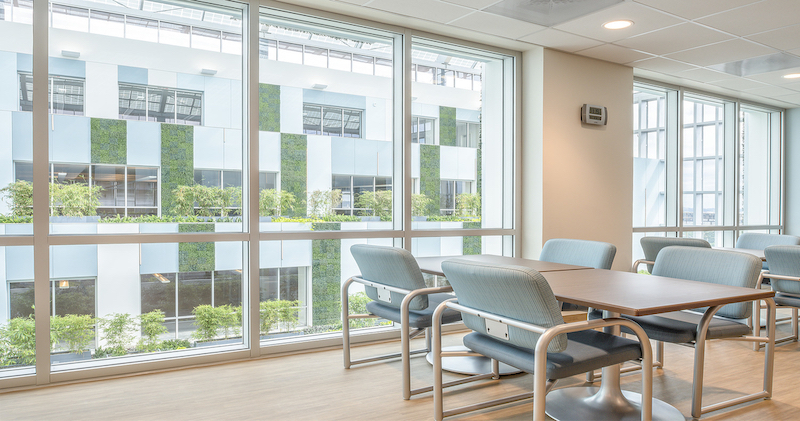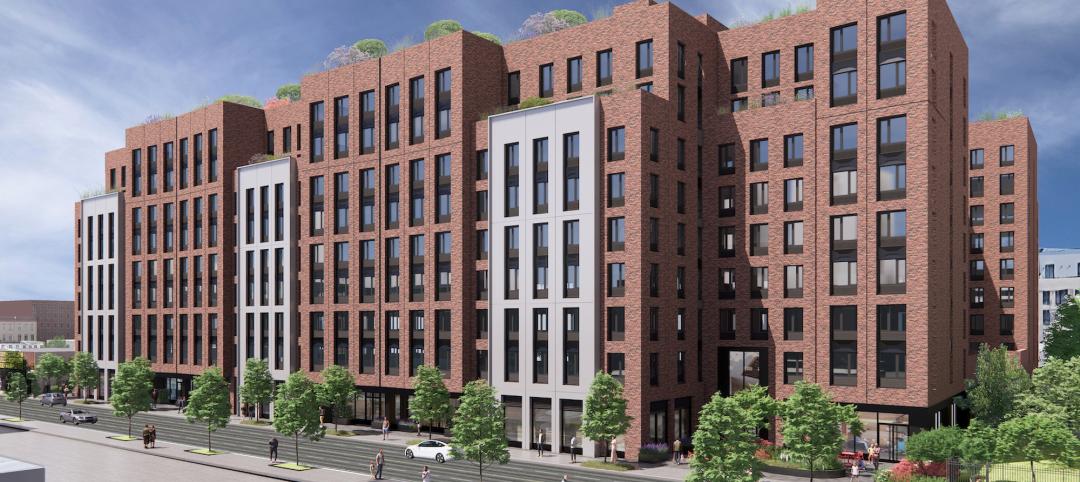The Strawberry Hill project came to be as our mental and behavioral health design team converted a former federal government office building into a behavioral health hospital focused on helping patients recover, heal and thrive. The flexibility designed into the building helped Shari Riley, MSN, BSN, RN, NE-BC, Director of Operations at Strawberry Hill Campus and Director of Nursing Behavioral Health Services at The University of Kansas Health System, adapt a portion of an inpatient unit into a COVID-only space without significantly disrupting operations and services of the rest of the facility. While there is no way to measure an outcome that didn’t occur, it’s fair to assume a less flexible building would have resulted in accelerated spread of the virus.
What Makes the Project So Flexible?
During the project’s design phase, it became clear that ensuring unit flexibility was paramount for staff to deliver the type of care aligned with their vision. By creating three separate pods, or neighborhoods, within a single 24-bed unit, the pods can operate as two smaller units, or three smaller units by controlling a series of cross-corridor doors. This flexibility provides the care team with the ability to separate populations by gender, age, or diagnosis if necessary. Each neighborhood of the unit has a clinical team station that provides visibility to the neighborhood, along with a multi-purpose activity room that can be used for therapeutic treatment, groups, dining, or daily activities. This allows each bed cluster to operate independently of one another, as was done when the coronavirus outbreak first started.
Riley and her team took a ten-bed pod on one unit, and turned it into a COVID-19 unit, with dedicated staff to run that area. Therapeutic activities and small group therapy sessions could continue, and these patients could also still eat in the associated activity room so they weren’t confined to their rooms. It also helped ease staff anxiety by knowing they were not going from a COVID-positive patient to a negative one.
Now that the number of COVID-positive patients has been consistently decreasing, the care team will transition the COVID unit from the original ten-bed pod to a smaller four-bed pod within the same inpatient unit. The ability of the unit to sub-divide not only helps manage constantly changing patient populations on a daily basis, but will be valuable as the potential for future surges or outbreaks remains possible.
The rest of the Strawberry Hill Behavioral Health Hospital saw reduced census numbers as government entities began issuing new stay at home guidelines. For those already receiving care in the facility, or any new patients that did arrive who were free of COVID symptoms, they were able to implement their own version of social distancing on each inpatient unit.
Patients who were not on the COVID unit were able to spread out into several co-located activity rooms during mealtimes keeping an appropriate distance from one another. This was possible due to the proximity of these spaces along with views being possible from one space to another to enable staff supervision of activities in multiple rooms simultaneously. By isolating COVID positive patients to one, four bed pod, the remainder of the facility can be brought back up to full occupancy and fully staffed to continue to meet the needs of the community during this crisis.
Since opening, Riley has been able to revamp Strawberry Hill’s entire treatment model because of the increased number of activity spaces and overall flexibility of the building’s design. Group services have been expanded, and there are now dedicated spaces to music and art therapy, giving patients more activities and therapy options to choose from.
Flexibility and adaptability are common goals for new healthcare facilities, and this pandemic has revealed that facilities capable of quick adaptability will drive better outcomes. Operating rooms were turned to ICUs, parking garages into testing sites and whole floors and units into isolation infection control spaces. Strawberry Hill’s inherent adaptability helped it be able to treat vulnerable patients who typically cannot delay care, and continuing caring for these patients as the pandemic continues to ebb and flow.
More from Author
CannonDesign | Jan 3, 2024
Designing better built environments for a neurodiverse world
For most of human history, design has mostly considered “typical users” who are fully able-bodied without clinical or emotional disabilities. The problem with this approach is that it offers a limited perspective on how space can positively or negatively influence someone based on their physical, mental, and sensory abilities.
CannonDesign | Oct 23, 2023
Former munitions plant reimagined as net-zero federal workplace
The General Services Administration (GSA) has embraced adaptive reuse with Building 48, an exciting workplace project that sets new precedents for how the federal government will approach sustainable design.
CannonDesign | Aug 22, 2023
How boldly uniting divergent disciplines boosts students’ career viability
CannonDesign's Charles Smith and Patricia Bou argue that spaces designed for interdisciplinary learning will help fuel a strong, resilient generation of students in an ever-changing economy.
CannonDesign | Jul 10, 2023
The latest pediatric design solutions for our tiniest patients
Pediatric design leaders Julia Jude and Kristie Alexander share several of CannonDesign's latest pediatric projects.
CannonDesign | May 11, 2023
Let's build toward a circular economy
Eric Corey Freed, Director of Sustainability, CannonDesign, discusses the values of well-designed, regenerative buildings.
CannonDesign | Apr 10, 2023
4 ways designers can help chief heat officers reduce climate change risks
Eric Corey Freed, Director of Sustainability, CannonDesign, shares how established designers and recently-emerged chief heat officers (CHO) can collaborate on solutions for alleviating climate change risks.
CannonDesign | Mar 9, 2023
5 laboratory design choices that accelerate scientific discovery
Stephen Blair, director of CannonDesign's Science & Technology Practice, identifies five important design strategies to make the most out of our research laboratories.
CannonDesign | Feb 9, 2023
3 ways building design can elevate bold thinking and entrepreneurial cultures
Mehrdad Yazdani of CannonDesign shares how the visionary design of a University of Utah building can be applied to other building types.
CannonDesign | Jan 9, 2023
How modular solutions can help address skyrocketing construction costs
Modular builder Joshua Mensinger details three ways modular solutions aid in lowering construction costs.
CannonDesign | Dec 9, 2022
What's old is new: Why you should consider adaptive reuse
While new construction allows for incredible levels of customization, there’s no denying that new buildings can have adverse impacts on the climate, budgets, schedules and even the cultural and historic fabrics of communities.
















